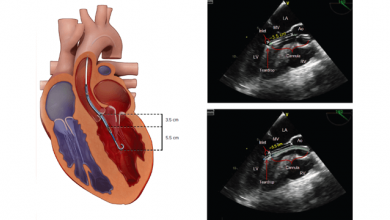Search results
PROMOTED
Author(s):
Nicolas M Van Mieghem
,
Kendra J Grubb
,
David Hildick-Smith
,
et al
Start date:
Mar 26, 2024
Blue Medical Devices
Supplier
A Review of the Impella Devices
Author(s):
Rami Zein
,
Chirdeep Patel
,
Adrian Mercado-Alamo
,
et al
Added:
2 years ago
Article
Author(s):
Chad A Kliger
Added:
3 years ago
Mitral regurgitation (MR) is a complex disorder requiring the understanding of mitral anatomy and pathophysiology. With the increasing patient population of mitral regurgitation, both functional and degenerative types, and our desire for less invasive treatment approaches, transcatheter mitral valve therapies (TMVT) have emerged. After more than a decade of advancements, development in TMVT still…
View more
Author(s):
Benjamin H Holland
,
Robert J Applegate
Added:
3 years ago
Manual compression has been the gold standard for obtaining haemostasis at the femoral artery access site since being introduced in conjunction with the Seldinger technique in the 1950s.1 However, the limitations of manual compression, including patient discomfort, delayed haemostasis and ambulation and bleeding at the access site despite satisfactory initial haemostasis, have spurred the…
View more
Author(s):
Alexander M Bernhardt
Added:
4 years ago
Author(s):
Martin G Radvany
Added:
3 years ago
Catheter-based vascular interventions continue to evolve as new devices continue to expand the capabilities of interventionalists and improve patient safety. The importance of athero-embolisation during vascular intervention has long been recognised.1 Embolic protection devices (EPDs) were developed to help prevent embolisation during endovascular procedures. The risk of distal embolisation is…
View more
Author(s):
Benjamin H Holland
,
Robert J Applegate
Added:
3 years ago
Abstract
Femoral access remains a vital route for many cardiac and non-cardiac procedures, including those involving the use of large delivery systems. In the common femoral artery access is extremely important to minimise complications and optimise use of closure devices. Dissatisfaction with haemostasis achieved by manual compression stimulated development of VCDs that provide quick and…
View more
Author(s):
Aman Ali
,
Timothy A Sanborn
Added:
3 years ago
Cardiogenic shock (CS) remains the leading cause of death among patients hospitalised for acute myocardial infarction (AMI), with mortality rates of approximately 50%.1 Even with the benefit of thrombolytic therapy and intra-aortic balloon pumps (IABPs), the in-hospital mortality rate of patients with CS from AMI was only lowered from 63 to 47% according to a report from the SHould we emergently…
View more
Author(s):
Maarten P van Wiechen
,
Jurgen M Ligthart
,
Nicolas M Van Mieghem
Added:
3 years ago
Minimally invasive procedures such as endovascular aneurysm repair (EVAR), transcatheter aortic valve implantation (TAVI) and implantation of mechanical circulatory support (MCS) are gaining ground on traditional surgery.1–3 These procedures require large-bore access, which is inherently associated with vascular complications and bleeding. Despite the reduction in size of these devices (Table 1),…
View more













